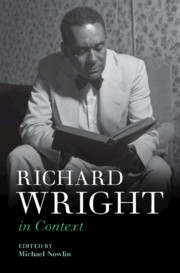Book contents
- Richard Wright in Context
- Richard Wright in Context
- Copyright page
- Contents
- Figures
- Contributors
- Abbreviations
- Richard Wright’s Works: A Chronology
- Introduction Richard Wright’s Luck
- Part I Life and Career, Times and Places
- Chapter 1 Richard Wright’s Triangulated South
- Chapter 2 Richard Wright’s Chicago
- Chapter 3 New York and Brooklyn
- Chapter 4 Paris and Ailly
- Chapter 5 Globetrotting, 1949–1960
- Part II Social and Cultural Contexts
- Part III Literary and Intellectual Contexts
- Part IV Reputation and Critical Reception
- Index
Chapter 5 - Globetrotting, 1949–1960
Wright’s Cosmopolitan Years
from Part I - Life and Career, Times and Places
Published online by Cambridge University Press: 08 July 2021
- Richard Wright in Context
- Richard Wright in Context
- Copyright page
- Contents
- Figures
- Contributors
- Abbreviations
- Richard Wright’s Works: A Chronology
- Introduction Richard Wright’s Luck
- Part I Life and Career, Times and Places
- Chapter 1 Richard Wright’s Triangulated South
- Chapter 2 Richard Wright’s Chicago
- Chapter 3 New York and Brooklyn
- Chapter 4 Paris and Ailly
- Chapter 5 Globetrotting, 1949–1960
- Part II Social and Cultural Contexts
- Part III Literary and Intellectual Contexts
- Part IV Reputation and Critical Reception
- Index
Summary
This essay details Wright’s extensive travels after his permanent relocation to France in 1946, including his long sojourn in Argentina for the filming of Native Son, and his stops, going and coming, in Trinidad, Uruguay, and Haiti, which brought him into contact with leading hemispheric intellectuals. Major concentration is given to Wright’s extended trips to Ghana; Spain; and Indonesia for the seminal Bandung Conference, journeys that brought him into contact with key global leaders such as Nkrumah and Nehru, and resulted in the important non-fiction works Black Power, Pagan Spain, and The Color Curtain. These travels and frequent talks he gave in various European countries are shown to have influenced a fourth non-fiction work, White Man Listen!. His meditations on his travels also had a part in his imaginative return to Mississippi in his final novel, The Long Dream, and in the global perspective of his innovative creation of hundreds of haikus. Wright’s cosmopolitanism sharpened his existing interest in travel writing, photography, ethnography, postcolonialism, and the possibilities of international bonds between people of color.
Keywords
- Type
- Chapter
- Information
- Richard Wright in Context , pp. 54 - 64Publisher: Cambridge University PressPrint publication year: 2021

